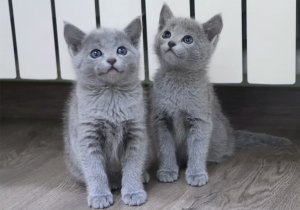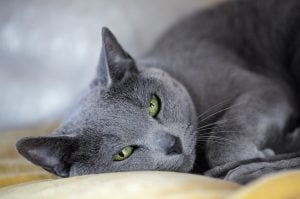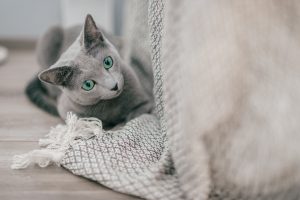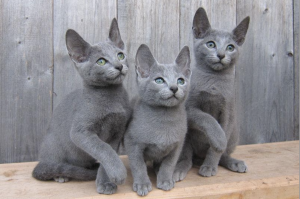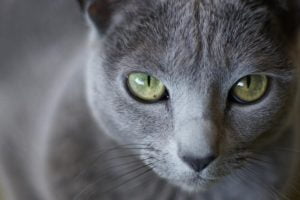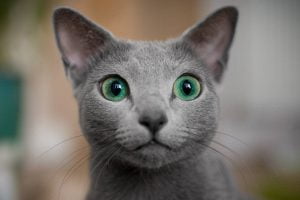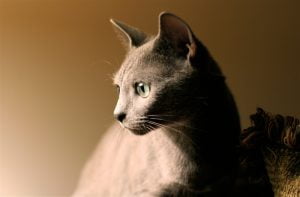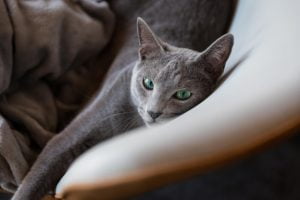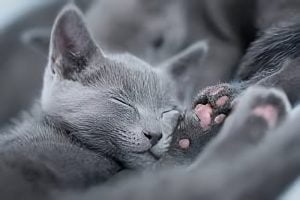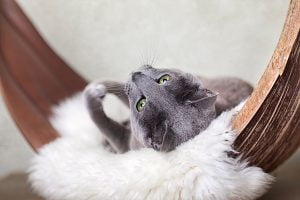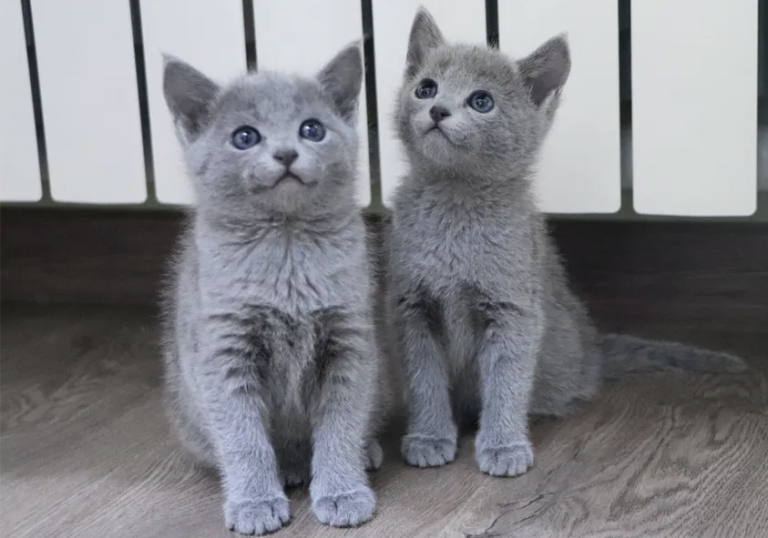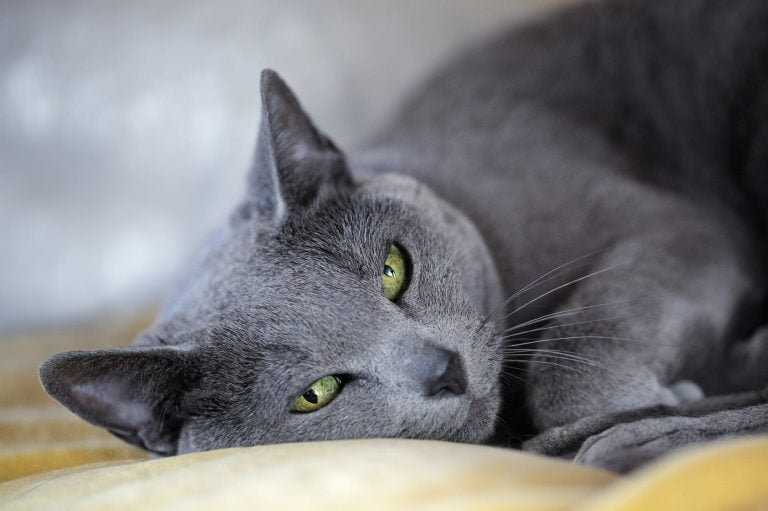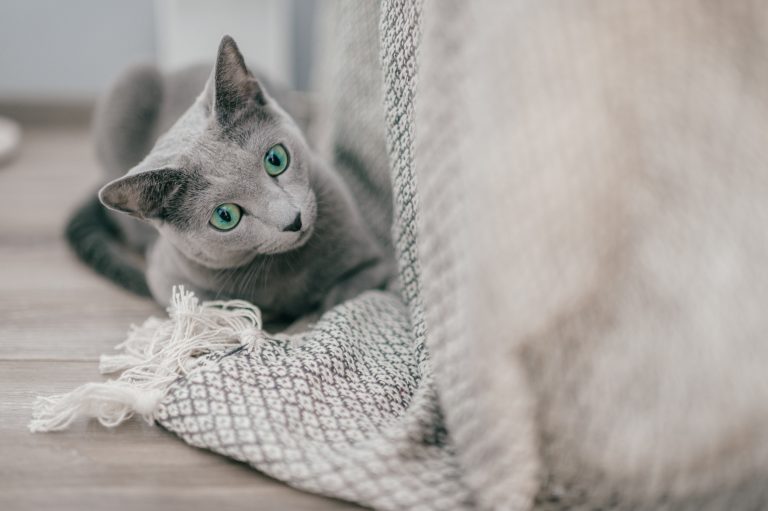Have you ever locked eyes with the shimmering blue coat of a Russian Blue cat, their bright green eyes gazing back? Their striking appearance might have you thinking, “Surely, this cat is a rare gem!” But before we’re swept away by their elegance, let’s separate myth from fact.
Russian Blue cats, with their sleek fur and endearing personalities, might not be spotted on every street corner, but that doesn’t make them the world’s most elusive feline. In fact, they’re not as rare as one might assume. Still, there’s no denying the allure of their distinct look. So, let’s dive deep into the world of the Russian Blue and uncover the truth behind their so-called rarity.
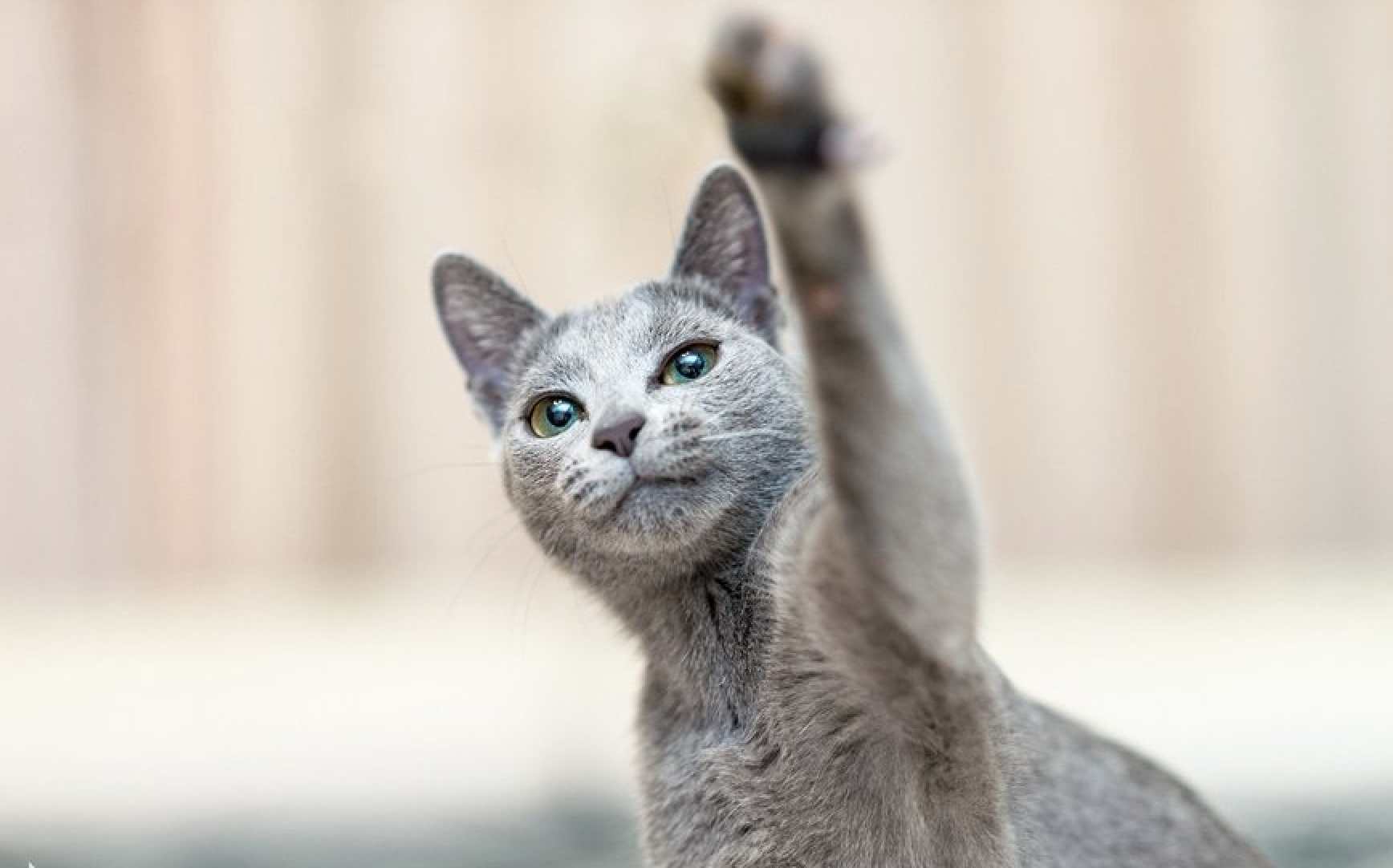
Short Facts About Russian Blue Cats
- Origin: Russian Blues originate from the Archangel Isles in Russia.
- Coat: They sport a dense, short coat of shimmering blue-gray fur.
- Eyes: Their bright green eyes are one of their most captivating features.
- Temperament: Russian Blues are known for their gentle, quiet, and intelligent nature.
- Shyness: They can be quite shy with strangers but are deeply loyal to their families.
- Health: Russian Blues are generally healthy, with a lifespan of around 15-20 years.
- Allergies: They are sometimes recommended for people with cat allergies due to their lower levels of certain proteins that cause allergic reactions.
- Grooming: Their dense coat requires minimal grooming, often just a weekly brush.
- History: It’s believed they were brought to Europe by sailors in the 1860s.
- Popularity: Russian Blues are not the rarest of breeds, but they aren’t the most common either, making them a unique choice for cat enthusiasts.
Is the Russian Blue Cat Rare Breed?
While the Russian Blue is not as commonly found as some domestic breeds, it is not classified as an extremely rare breed. Its rarity or commonness can vary depending on the region or country. Here are some insights:
- Historical Background: Originating in Russia, this breed has a rich history. It gained popularity in various parts of the world after it was showcased in cat shows in England in the late 19th century.
- Popularity: Over the years, the Russian Blue has become more recognized and sought after. In some areas, they might be less common, which can lead to a perception of rarity.
- Distinguishing Features: Part of the perceived rarity may come from the specific characteristics that set the Russian Blue apart from other cats. Its short blue-gray coat, green eyes, and sleek body make it easily distinguishable.
- Breeding Standards: True Russian Blue cats that adhere to strict breed standards may be less common than those with mixed ancestry. Reputable breeders maintain the breed’s purity, which can make genuine Russian Blues more scarce in some areas.
- Misidentification: It’s worth noting that not all blue or gray cats are Russian Blues. Cats like the British Shorthair, Chartreux, Korat, and Blue Persian can sometimes be mistaken for Russian Blues, leading to a misconception about their rarity.
In conclusion, while the Russian Blue is not an extremely rare breed, it holds a special place in the hearts of cat aficionados due to its unique appearance and charming personality. Its availability can vary based on region and demand, but it remains a beloved choice for many cat lovers worldwide.
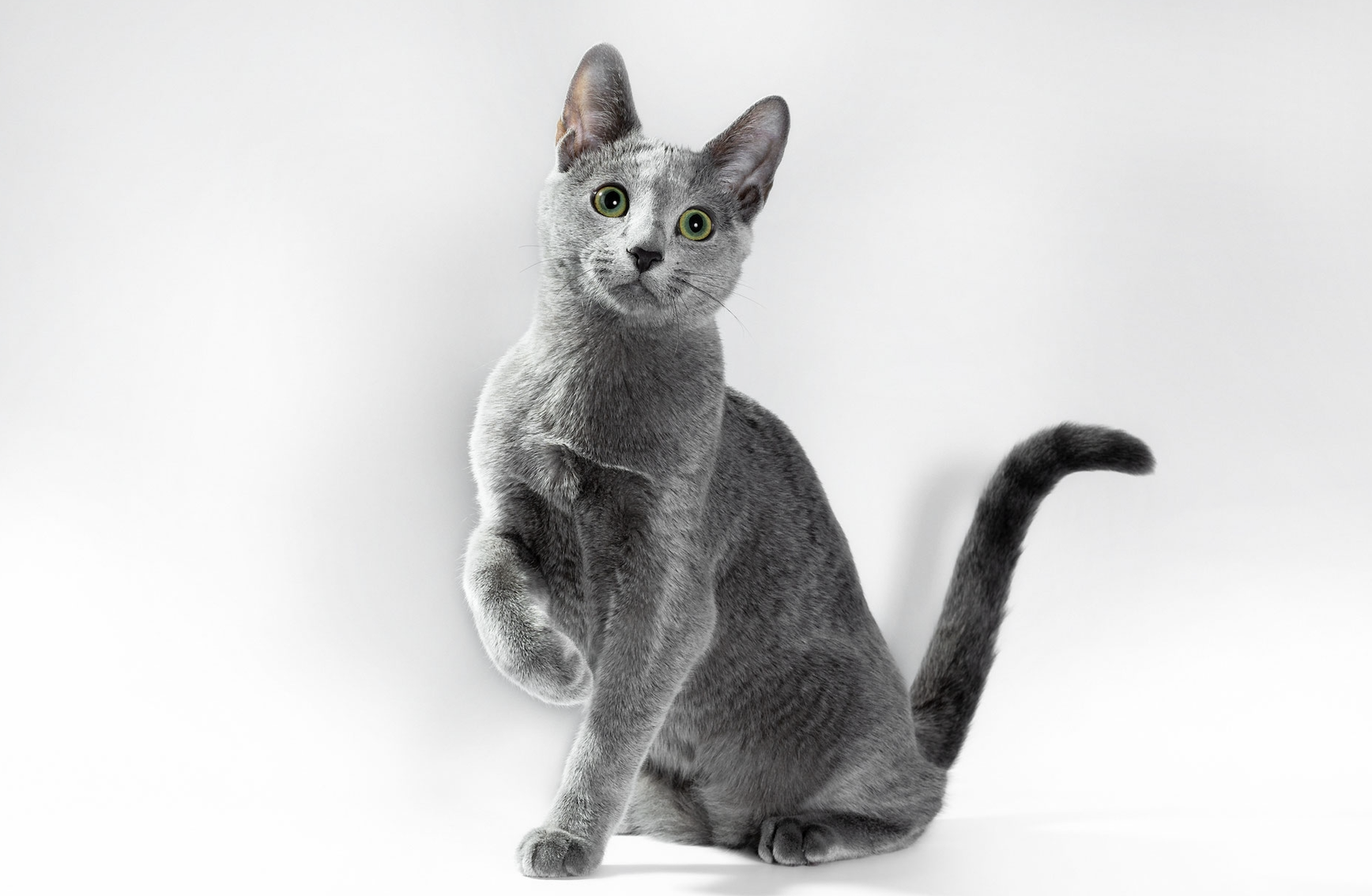
Are Russian Blue Really Blue?
No, Russian Blue cats are not actually blue. The term “blue” in the context of cat breeds often refers to a solid gray color. The real color of a Russian Blue cat is a deep, even bluish-gray.
This shade gives them a slightly bluish hue, especially under certain lighting conditions. Combined with their dense, fine coat, it can sometimes shimmer and further enhance the “blue” appearance. Their distinctive bluish-gray coat paired with bright green eyes gives them a unique and captivating look.
Are All Grey Cats Russian Blue Cats?
Just because a cat is grey doesn’t mean it’s a Russian Blue. There’s a world of difference between various cat breeds, and while color might be the first thing you notice, there are several other markers to help identify a true Russian Blue.
Highlighting Key Differences with Other Gray Breeds:
- Coat Texture and Shine: While Russian Blues have a dense, plush coat with a noticeable sheen, other gray cats, like the British Shorthair, have a denser, more rounded body with a different coat texture.
- Eye Color: One of the standout features of Russian Blue cats is their striking, bright green eyes. Other gray cat breeds might have copper, gold, or even blue eyes.
- Body Structure: Russian Blues are sleek, slender, and muscular with fine bones. In contrast, breeds like the Chartreux are more robust and have a sturdier build.
- Temperament: Russian Blues are known for their gentle, shy, and reserved nature. While temperament can vary widely among individual cats, other breeds might have distinct behavioral traits.
- Origins and History: Russian Blues are believed to have originated in northern Russia. In contrast, the Korat, another gray cat, has its roots in Thailand.
Important Markers to Identify a True Russian Blue:
- Distinct Color: A uniform bluish-gray coat is a trademark of the Russian Blue. The coat shouldn’t show any patches, stripes, or spots.
- Face Features: Russian Blues have a unique face with a short, blunt wedge shape, high cheekbones, and a straight nose.
- Green Eyes: As kittens, Russian Blues might start with yellow eyes, but they turn bright green as they mature.
- Body Posture: They are graceful and elegant, often moving with a quiet, regal grace.
- Personality: Often reserved around strangers, they form deep bonds with their human companions and can be incredibly loyal.
In conclusion, while many cats might share a similar gray hue, various distinguishing characteristics set the Russian Blue apart from other breeds. If you’re in doubt, consulting a cat breed expert or getting a DNA test can confirm a cat’s lineage.
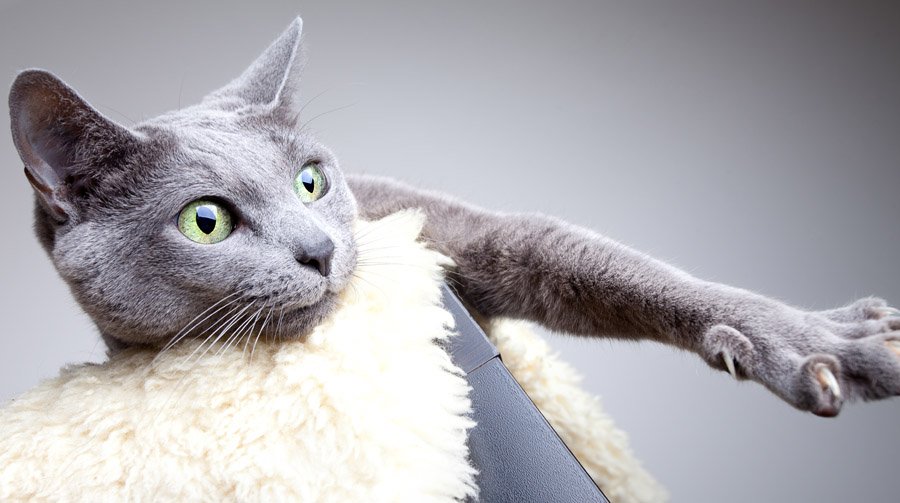
Gray Cats Often Mistaken for Russian Blue: A Closer Look
The enigmatic allure of the Russian Blue, with its plush bluish-gray coat and sparkling green eyes, has undoubtedly left many feline enthusiasts wondering whether they’ve spotted one in the wild. However, several other gray cat breeds often get misidentified as Russian Blue due to their similar coloration. Let’s delve into some of the main distinctions:
- British Shorthair:
- Color: Comes in various shades, but the blue variant is the most popular.
- Coat: Dense and plush, but with a more rounded appearance compared to the Russian Blue.
- Eyes: Typically have deep copper or gold eyes.
- Body: Stockier build with a broad chest and round face.
- Chartreux:
- Color: Bluish to slate gray.
- Coat: Medium-short, dense, and water-repellent with a woolly texture.
- Eyes: Gold to copper, although kittens may have blue or green eyes.
- Body: Robust with a muscular physique, broad shoulders, and a rounded head.
- Korat:
- Color: Silver-tipped blue that gives them a shimmering appearance.
- Coat: Short to medium, close-lying, and glossy.
- Eyes: Peridot green, which is a hallmark of this breed.
- Body: Semi-cobby and muscular, with a heart-shaped face.
- Blue Persian:
- Color: Soft blue-gray.
- Coat: Long, thick, and requires regular grooming.
- Eyes: Typically have deep copper or blue eyes, though green is also possible.
- Body: Compact and cobby with a broad head and short nose.
While the Russian Blue and these breeds might share a grayish hue, the distinctions, from the texture of their coat to their body structure and eyes, are clear upon closer inspection. If you’re contemplating getting one of these cats or identifying a stray, it’s vital to know these nuances to make an informed decision or identification.
A Russian Blue Cat: Uncommon vs. Rare
The elegant Russian Blue cat, with its mesmerizing green eyes and silver-tipped blue-gray coat, has long captured the imagination of cat enthusiasts. But is this breed truly rare, or is it simply less common than others? Let’s unravel the mystery behind its perceived rarity and the misconceptions surrounding its popularity.
Misconceptions and the Truth About Their Popularity:
- Perceived Rarity: While the Russian Blue may not be seen lounging in every other household, this doesn’t automatically make it a rare breed. Instead, it’s more accurate to describe the Russian Blue as uncommon compared to more widespread breeds.
- Misidentification: The unique coloration of the Russian Blue is sometimes confused with other gray-hued cats. Breeds like the British Shorthair, Chartreux, and Korat, among others, are often mistaken for Russian Blues. This can lead to inflated perceptions of their presence and, by extension, misconceptions about their rarity.
- Selective Breeding: Genuine Russian Blue cats that adhere to strict breed standards might be less frequently found, especially when compared to those with mixed heritage. This selectivity in breeding can influence the perception of their scarcity.
Role of History in Shaping the Perception of Rarity:
- Origins: The Russian Blue traces its roots back to the northern parts of Russia. Their silvery coats were believed to have kept them warm in the chilly Russian climate. Their exotic origin story has contributed to the allure and intrigue surrounding the breed.
- Showcase in England: After being introduced in England in the late 19th century, the Russian Blue quickly gained attention in the world of cat fanciers. Its initial uniqueness in European cat shows might have played a part in its perceived rarity.
- World Wars: The two World Wars had a significant impact on the breed. The numbers of Russian Blues dwindled, and post-war breeders had to be careful in reviving the breed without diluting its distinctive features. This historical challenge has played into the narrative of the Russian Blue being rare.
- Modern Perception: Today, thanks to effective and dedicated breeding, the Russian Blue is neither endangered nor extremely rare. However, its historical journey, combined with its unmistakable appearance, has left an enduring impression of the breed as being exclusive and unique.
In conclusion, the Russian Blue cat, while uncommon in some regions, isn’t necessarily a rare breed. Its rich history and distinct appearance have shaped perceptions, making it a breed that’s both admired and surrounded by myths. It’s essential to differentiate between the notions of being “rare” and simply “less common” to truly appreciate the Russian Blue’s place in the feline world.
Why Do People Think Russian Blue Cats Are Rare?
The idea of the Russian Blue cat being rare is a prevalent misconception. Their enigmatic aura, combined with several factors, has contributed to this belief. Here’s a deeper dive into why people often perceive Russian Blues as rare:
- Distinct Appearance: The Russian Blue’s silvery-blue coat, deep green eyes, and graceful physique make it stand out. Such a striking appearance can easily be mistaken for rarity, especially when people don’t often encounter such cats in their day-to-day lives.
- Misidentification: Many gray cats are mistakenly labeled as Russian Blues by their owners or observers, especially if they aren’t familiar with the specific traits of the breed. When a genuine Russian Blue is identified, it might be deemed rare because of the many misidentified ones.
- Selective Breeding: Russian Blues that strictly adhere to breed standards are selectively bred. This selectivity can limit their numbers, especially when compared to more commonly found domestic cats.
- Historical Events: The impact of the World Wars led to a significant decrease in the numbers of Russian Blues. Their population had to be painstakingly rebuilt post-war, which might have contributed to the notion of their scarcity during specific periods.
- Exclusivity in Cat Shows: In the world of cat fanciers, Russian Blues have often been prized and showcased for their elegance and unique traits. Their special status in such shows might have indirectly hinted at their rarity to the general public.
- Stories and Myths: Every breed has its legends, and the Russian Blue is no exception. Stories of its origins from the Russian port city of Arkhangelsk, its favor among royals, and its mysterious demeanor have all woven a tapestry that hints at rarity and exclusivity.
- Limited Availability: In some regions or countries, finding a purebred Russian Blue might be challenging. This limited availability, often due to high demand and fewer breeders, can reinforce the idea that the breed is rare.
- Price Point: High-quality Russian Blue kittens, especially those fit for shows, can be on the pricier side. Higher costs can often be misconstrued as an indicator of rarity.
In conclusion, while the Russian Blue cat may be less common in some areas and has certain unique traits that set it apart, it isn’t as rare as many believe. The amalgamation of history, appearance, and public perception has played a significant role in shaping the myth of its rarity.
How Much Does a Russian Blue Cat Cost?
The cost of a Russian Blue cat can vary widely based on various factors, such as the cat’s lineage, age, the breeder’s reputation, geographical location, and the demand for this particular breed. Here’s a general breakdown of the costs you might encounter:
- Pet-Quality Russian Blue: These cats might not meet the strict breed standards for cat shows but make wonderful pets. Prices for pet-quality Russian Blues can range from $900 to $1,500.
- Show-Quality Russian Blue: These cats adhere strictly to the breed standards and might come from a lineage of award-winning cats. As such, they are priced higher, typically ranging from $1,600 to $3,000 or even more.
- Breeders: Reputable breeders who are known for producing high-quality cats, adhere to ethical breeding practices, and offer health guarantees might charge more. Always ensure that the breeder is legitimate and provides appropriate health screenings for their kittens.
- Geographical Location: The cost of a Russian Blue cat can also depend on your geographical location. In areas where the breed is more popular or where there are fewer breeders, prices might be higher.
- Age: Kittens usually cost more than adult cats. However, adult cats that are retired from breeding or shows might still carry a higher price tag due to their lineage.
- Included Services: Some breeders offer packages that include initial vaccinations, spaying/neutering, microchipping, and a health guarantee. This can affect the overall cost.
- Adoption: Adopting a Russian Blue from a rescue or shelter can be a cost-effective option, with adoption fees typically ranging from $50 to $150. However, keep in mind that genuine Russian Blues are quite rare in shelters, and many cats that are labeled as “Russian Blue” in such settings might be mixes.
It’s essential to do thorough research before purchasing a Russian Blue cat. While cost is a factor, it’s equally crucial to ensure that you’re supporting responsible breeding practices and that you’re prepared for the responsibilities of cat ownership. Remember, the initial cost of purchasing the cat is just the beginning; there are ongoing costs for food, medical care, toys, and other necessities to consider.
Why Are Russian Blue Cats So Expensive If They’re Not Rare?
The cost of a Russian Blue cat might raise eyebrows, especially if one considers that they aren’t classified as a “rare” breed. So, why do these cats carry a relatively high price tag? Here are a few reasons:
- Breeding Standards: Reputable breeders adhere to strict breeding standards to maintain the purity and health of the breed. This involves careful selection of breeding pairs, regular health checks, and ensuring genetic diversity. All these factors contribute to higher breeding costs, which in turn affects the price of the kittens.
- Health Screenings: Russian Blue cats, like other breeds, can have specific genetic conditions. Reputable breeders invest in health screenings to ensure that the kittens they produce are healthy. This upfront investment in the health of the cats can drive up costs.
- Initial Care: When purchasing from a responsible breeder, the price often includes initial veterinary care such as vaccinations, deworming, and sometimes even spaying or neutering. This comprehensive care in the early stages of the kitten’s life adds to the overall price.
- Demand vs. Supply: While Russian Blue cats aren’t “rare,” the demand for them often exceeds the number of available kittens, especially from reputable breeders. This high demand relative to supply can drive up prices.
- Unique Features: Russian Blue cats are sought after for their distinct appearance — their dense, short, and shimmering blue coat paired with striking green eyes. This distinct look, combined with their pleasant personality traits, makes them particularly desirable, allowing breeders to charge a premium.
- Long Lifespan and Fewer Health Issues: Russian Blues are known for their robust health and long lifespan when compared to some other cat breeds. For many potential cat owners, this is a selling point, knowing that they might have fewer veterinary bills in the future.
- Breeder Reputation: Breeders with a long-standing reputation for producing healthy, well-socialized kittens might charge more than newer or less-known breeders. This is often a reflection of the breeder’s experience, dedication to the breed, and the quality of care they provide to their cats.
In conclusion, while the Russian Blue cat isn’t necessarily rare, the costs associated with ensuring high standards of breeding, care, and health contribute to their price. For those considering adopting a Russian Blue, it’s essential to view the purchase as an investment in a healthy, well-bred companion rather than just a simple transaction.
Bottom Line
Russian Blue cats, with their shimmering blue coats and captivating green eyes, are often perceived as rare, leading many to wonder about their true status and cost. Despite the common misconception, Russian Blues aren’t classified as a “rare” breed. Their price tag, however, can be on the higher side. This expense is attributed to strict breeding standards, health screenings, initial veterinary care, and the breed’s unique features. Moreover, the demand often outweighs the supply, especially when it comes to reputable breeders. While these cats might not be rare, their distinctive looks and charm make them a sought-after companion, making it essential to understand their true value beyond mere rarity.

